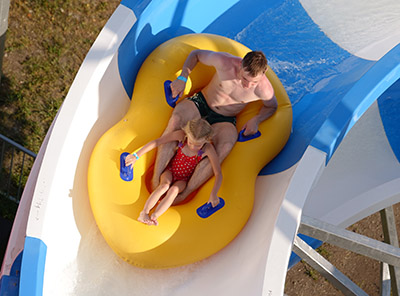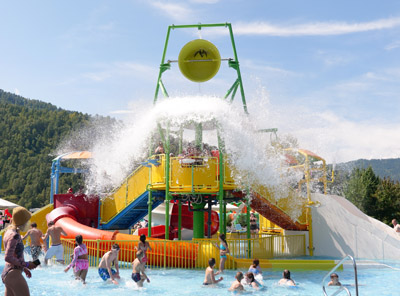Optimizing the Length of Water Park Slides: Key Factors in Design and Rider Experience
The length of a water park slide is a critical element that influences rider enjoyment, safety, and operational efficiency. Unlike height, which primarily affects speed and thrill intensity, slide length determines the duration of the experience, the complexity of the ride, and the physical space required for construction. Engineers and designers carefully calculate optimal lengths by considering multiple variables, from hydrodynamics to visitor demographics.
Hydrodynamics and Speed Control
Water slides rely on gravity and water flow to propel riders, and length plays a pivotal role in regulating speed. A longer slide allows for gradual acceleration, creating a smoother ride that builds anticipation. For example, a 100-meter slide with a gentle incline might take 20–30 seconds to descend, giving riders time to enjoy twists and turns. In contrast, a shorter, steeper slide of 30 meters could reach terminal velocity in under 10 seconds, resulting in a more abrupt but intense experience.
Engineers use fluid dynamics principles to model water flow and friction. The slide’s surface material, water volume, and rider weight all impact speed. A longer slide requires precise calculations to ensure water pressure remains consistent throughout, preventing riders from getting stuck or accelerating uncontrollably. Adjustable water jets or textured surfaces may be incorporated to fine-tune speed, especially in sections where riders need to slow down before sharp turns or drops.
Rider Engagement and Experience Variety
The length of a slide directly affects how riders interact with the attraction. Longer slides enable designers to include multiple features, such as loops, waves, or dark tunnels, which enhance entertainment value. For instance, a 150-meter slide might combine a steep initial drop with a winding helix and a final splash pool, offering a dynamic journey that appeals to thrill-seekers. Shorter slides, while less complex, can still be engaging by focusing on a single dramatic element, like a sudden vertical drop or a 360-degree loop.
Visitor demographics also influence length decisions. Family-oriented parks often prioritize moderate-length slides (50–80 meters) that accommodate riders of all ages without overwhelming them. These slides might include interactive elements, such as water cannons or timed obstacles, to keep children entertained. Extreme parks targeting adolescents and adults, however, may opt for slides exceeding 200 meters, emphasizing endurance and adrenaline. The goal is to match slide length with the target audience’s preferences, ensuring repeat visits and positive word-of-mouth.
Space Constraints and Construction Feasibility
Practical considerations like available land and zoning regulations often dictate slide length. Urban water parks or those located in densely populated areas may face spatial limitations, forcing designers to maximize vertical height instead of horizontal length. In such cases, compact slides with multiple vertical drops or spiral designs can deliver excitement without requiring extensive footprint. Conversely, parks with ample space might invest in meandering slides that snake through landscapes, creating a sense of exploration.
Construction costs also rise with slide length. Longer slides demand more materials, labor, and maintenance, particularly if they incorporate advanced features like enclosed tubes or lighting systems. Engineers must balance ambition with budget constraints, ensuring the slide remains profitable while meeting safety standards. Modular slide components, which allow for customizable lengths and configurations, have become popular solutions for parks seeking flexibility without excessive costs.
Safety and Accessibility Standards
Regardless of length, safety is paramount. International guidelines, such as those from ASTM International or the European Committee for Standardization (CEN), specify minimum and maximum lengths based on slide type and intended user group. For example, slides designed for toddlers are typically limited to 10–15 meters to prevent fatigue and reduce the risk of injury during exits. Adult-oriented slides, however, can extend beyond 300 meters, provided they include emergency exits, non-slip surfaces, and clear signage.
Accessibility is another consideration. Longer slides should incorporate multiple entry and exit points to accommodate riders with disabilities or those needing frequent breaks. Staircases or ramps leading to the top must comply with ergonomic standards, ensuring comfortable ascent and descent. These features not only improve safety but also broaden the slide’s appeal to diverse visitor groups.
Environmental and Operational Impact
The length of a slide affects water consumption and energy use. Longer slides require larger pumps to maintain consistent water flow, increasing electricity demands. To mitigate this, parks adopt water-saving technologies like recirculation systems, which filter and reuse water, or variable-speed pumps that adjust output based on rider volume. Additionally, longer slides may generate more noise, prompting designers to position them away from residential areas or use sound-dampening materials.
Operational efficiency is another factor. Slides with excessive length might experience congestion during peak hours, as riders take longer to complete the journey. Parks address this by staggering start times or adding parallel lanes to high-capacity slides. Data analytics tools help operators monitor rider flow and adjust slide lengths or configurations to optimize throughput without sacrificing safety or enjoyment.
By integrating these considerations, water parks can design slides that strike the perfect balance between excitement, practicality, and sustainability. Whether it’s a compact urban attraction or a sprawling resort feature, the length of a slide shapes its identity and ensures it remains a memorable part of the visitor experience.






